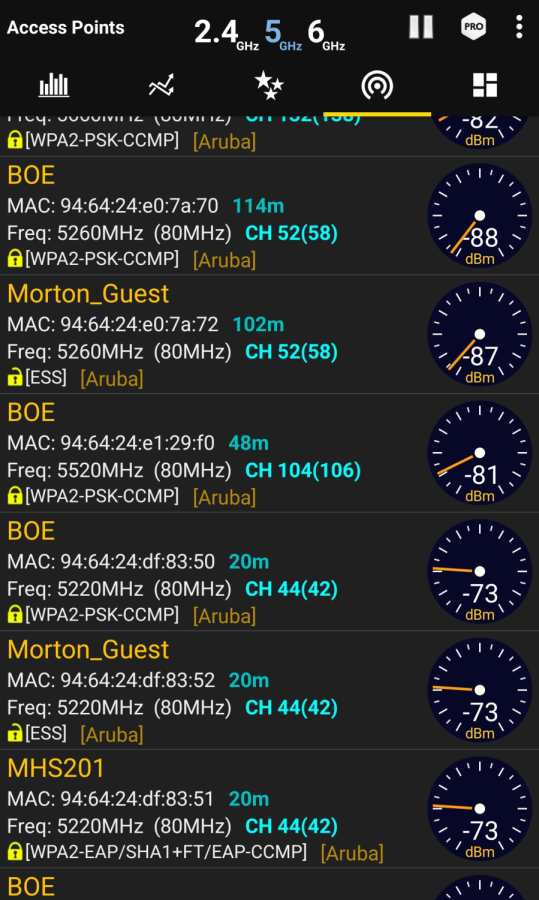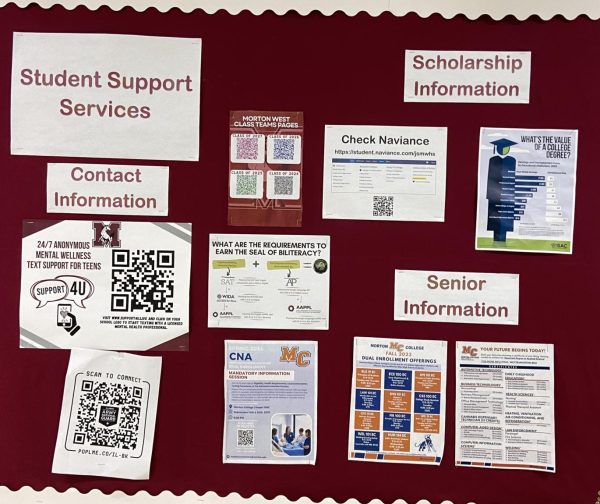TechOps: How Secure is Morton’s WiFi?
Related Stories
Throughout the years, both of us tech columnists have heard claims that WiFi connections in certain parts of the building are either worse or better than others. Such claims as C-Hall having the worst WiFi and D-Hall having some of the best, among others, have laid unsubstantiated for years. Does Morton’s WiFi truly vary that much, and if so, to what extent?
This week, along with our Cybersecurity Correspondent and friend Justin Kobza, we went throughout the halls of the school and recorded the strength of WiFi connections as we passed them. But before we can begin, many readers must be wondering, as we were, how does Morton’s WiFi work?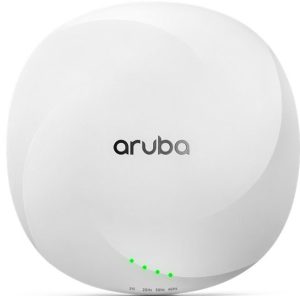
How Does it Work?
Before we can describe the strength of connection throughout Morton though, you have to take into consideration how the WiFi works. Luckily, our aforementioned Cybersecurity Correspondent, Justin, has extensive hands-on experience with network management and architecture. Working under his father’s tutelage resolving network issues in hotels and other similar buildings and systems, alongside his personal interest in technology, Justin has developed an intricate understanding of how networks function both physically and digitally.
Physically:
According to Justin, networks such as the ones at our school, that is to say large, closed, building-wide networks, are composed of physical lines, typically fiber, which are plugged into a switch. “The switch takes the fiber. It transforms it so it can be used over Ethernet, and from those switches you have many more switches to different, important points around the school,” Justin says.
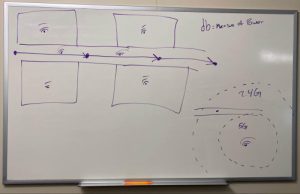
“There’s gonna be what [are] called ‘distribution closets’ where these switches lead to. In these distribution closets there are more switches. These switches are connected, ran through the walls and around the school, [where] we have, you can call them ‘access points’ or ‘extenders’. Basically, they take Ethernet from the switch and allow you to connect to WiFi anywhere.” You can think of a switch as an individual, physical connection to the network as a whole. In short, all the routers throughout our school are actually connected via Ethernet cables that run through the walls and ceilings to a main ‘switch’ where the WiFi is actually coming from.
Digitally:
Regarding the software side of network management, Justin says that, “…your phone or your computer or your laptop will recognize the SSID of the WiFi.” The SSID, or “Service Set Identifier”, is essentially the name of the network. “When your device recognizes the “name,” it checks which signal is the strongest, so no matter where you are, you’ll connect to the same SSID no matter what hotspot/access point that will be,” he elaborates. This means that your device isn’t actually connected to the same network throughout the day, and rather seamlessly connects to the “MHS201” network with the strongest, compatible network.
Compatibility matters because of the two signals routers produce! This might come as a shock to many, but according to the official Aruba website’s WiFi radio specifications, the models Morton use, the 600 series, output both 2.4GHz and 5GHz band connections. 2.4G connections cannot transfer a lot of data, but have an extremely large range, making them perfect for devices like the card readers on the doors around the school. According to CNN, 5G greatly reduces latency, which means requests to a server (loading a website, submitting assignments, downloading images, etc.) will be much faster. Additionally, 5G connections have greater bandwidth than their predecessors, which allows a lot of devices to connect to the network before slowing down.

Furthermore, as 2.4G and 5G signals are frequencies on a band, different connections, in this case the different connections which the WiFi extenders put out, are subdivided. These subdivisions are called “channels.” “…data transferred from a device to a router will not be interfered by another one by a different device to a different router because they’re on separate channels, even if they’re on the same frequency range,” Justin says, “So basically, to prevent ‘noise’ in the signal and signal loss.”
On the Field:
After our interview with Justin, we set out to do some field work in order to collect data for our experiment. Using “WiFi Analyzer”, an app Justin had on his phone, we were able to test the connection speed of both 2.4GHz and 5GHz connections from throughout the halls and open, congested points of interest. Seeing as we wanted to stress-test the strength of Morton’s WiFi connections, we intentionally tested in rigorous, high-use environments.
Out of our nineteen recorded data points, two did not fit the criteria of our stress-test: our control variable, and an interesting outlier. Our control variable, representative of the typical connection strength within a classroom, was the router used in the classroom section of TSI. Directly under the router, as all students within a classroom practically are, it had a connection strength of -44 dBm. According to signalboosters.com, “dBm” stands for “decibels per milliwatt,” which basically means it’s a calculation for the signal strength provided by one milliwatt of power. As the image alongside this paragraph clearly shows, this is an extremely strong and reliable connection. Additionally, we realized we had to take out our data collected in W-hall, as it boasted a -34 dBm connection, but only because, strangely, it had two routers placed directly beside each other.
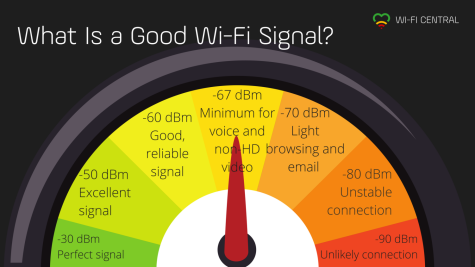
Conclusion:
Average Connection Strength: -61.89 dBm.
Strongest Connection Strength: -55 dBm, Knowledge Center.
Weakest Connection Strength: -79 dBm, C-Hall Stairs.
As is stated above, the average connection strength of all our stress-test data was -61.89 dBm. According to the diagram above and ScreenBeam.com, at it’s worst, Morton’s WiFi is still reliably able hold a strong, respectable signal. Additionally, they note that -67 dBm is the minimum for online services which host video and voice to function. Only the two worst connections recorded in the school, one being a stairwell and one being a crowded lunchroom, dipped below this threshold. The average provided by TSI and the average connection strength suggest that Morton’s WiFi, as used by students in everyday situations, not only has a consistently adequate connection strength, but one that is extremely strong.

Michael Khan is a high school senior and writer for J.S Morton West High School's digital magazine, "The Sterling." After high school, he is considering...

Jose (Sebastian) Arenaza, a senior is a writer for The Sterling. the digital magazine of J.S. Morton West High School. After high school, he has no idea...



